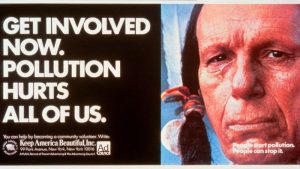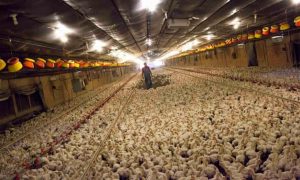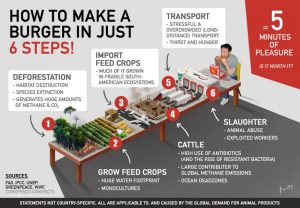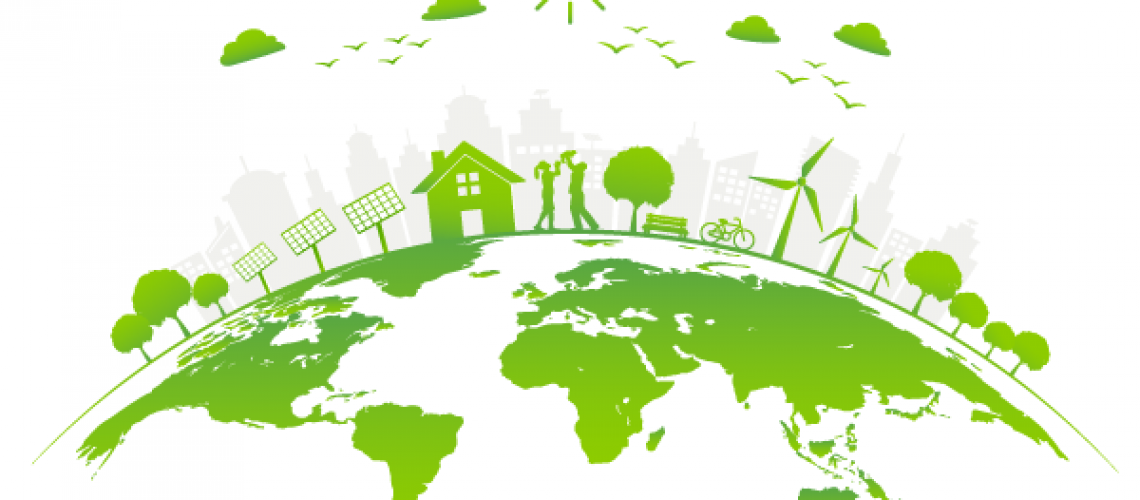Guest Post By Pascal Jundt, 2020-2021 Sustainability Leadership Fellow and Ph.D. Candidate in the Department of Physics
Recycle. Turn down the air conditioning. Buy an electric car. Hang-dry clothes. Fly less. Buy more efficient lightbulbs. Have fewer kids. Be conscious of your carbon footprint. This is how we save the planet, right? At least this is what we are told. This is the mainstream narrative of sustainability: individual actions are the key. The impending climate catastrophe is our fault as consumers, and it is up to us to make sacrifices to fix it.
With a bit of scrutiny, it becomes apparent that this is all a load of bull. Individual action is perhaps the most successful implementation of blame shifting in human history. Perhaps the earliest example of greenwashing, the “keep America beautiful” ad campaign with the famous crying Indian PSA from 1971 imploring us to recycle was the product not of environmentalists, but of a coalition of beverage and tobacco companies who didn’t want to be responsible for their trash. Sure enough, even the phrase “carbon footprint” was coined by British Petroleum in the early 2000s to browbeat environmentally-conscious consumers into taking responsibility for climate change and remove themselves, the 6th highest corporate cumulative emitter of carbon in the world, from the conversation. Think about it. Are we the consumers actually the ones making our plastic garbage? Then why are we the ones responsible for recycling it? We consume vast amounts of energy, but that is only because our society imposes this consumption upon us. Would you commute for an hour or more each day by car if you didn’t have to? Do you like that your electricity comes from fossil fuels? If you wanted to halve your garbage generation, would that even be possible? Do you realistically have a choice in any of this?

The truth is that individual actions, while certainly good and worthwhile, will forever fall hopelessly short of having the needed impact to prevent climate catastrophe. You can’t just stop using electricity. You can’t just stop driving. Every item you need to survive comes wrapped in garbage. You are forced to consume energy and destroy the environment because it is very profitable for a small group of powerful capitalists. Living truly sustainably effectively means removing yourself from modern society, an untenable extreme move which likely is not even possible (where would you legally be able to go?). Tackling climate change requires collective action. It requires strong government intervention and substantial structural changes, all of which absolutely need to be done, but all of which are well beyond the scope of actions individuals can possibly take. With this knowledge, things can sometimes feel hopeless.
There is one exception, however. There is one realm where individual actions lead to proportional impact. There is one relatively easy change that any individual can implement, at any time, that would collectively add up to a massive benefit. This change wouldn’t require a dramatic societal, infrastructural, and political restructuring, and life for the individual barely changes, or changes in a positive way. The solution is beautiful in its simplicity:
Stop eating meat.
Or at least eat a whole lot less of it.
Animal agriculture is responsible for 51% of global greenhouse gas emissions each year. This dwarfs the contribution by the transportation and energy generation sectors. This obscene amount of emissions and consumption simply reflects an unavoidable fundamental inefficiency. Animals turn plant calories into meat calories. Of course, over the course of the 18-22 months of an average beef cow’s life before it is slaughtered, a vast majority of the plant calories eaten by that cow are simply used to keep the cow alive, and are not turned into meat calories. For this reason, producing meat requires an incredible amount of food. America produces a lot of food. But most of that food isn’t for us. It’s for our animals. Only 1/8th of the grain crops grown in the United States are for human consumption; the rest are for livestock. The amount of food grown explicitly for livestock in the United States could feed 840 million people following meat-free diets. Why not just cut out the middleman and eat the plants directly?
This colossal inefficiency has many staggering consequences. 56% of the water consumed in the United States is directly for animal agriculture. It takes 2500 gallons of water to produce just one pound of beef. One pound! We are headed for severe water shortages in the next few decades in the United States, yet we use half of our water on a needless indulgence. 41% of all land in the contiguous United States is used for feeding livestock. This compares with just 25% of the land covered by forests (it was 46% in 1630) and 3% for national parks. Factory farming necessitates the reckless usage of antibiotics which breeds antibiotic-resistant germs; 80% of antibiotic consumption in the US is by livestock. I am not even discussing the abysmal working conditions meatpackers are subjected to, nor the myriad ways in which factory farms pollute waterways, soil, and air, particularly (and deliberately) affecting low-income and minority areas. Nor am I mentioning the psychotic cruelty to which we subject billions of farm animals to each year before we slaughter them with inhuman mechanized efficiency.

This problem is not limited to the United States. Looking to the future, consumption of animals is catastrophic on a global scale. The West sets an example for the world in this regard. Consumption of meat is a sign of wealth. As countries industrialize, meat consumption increases dramatically. For example, meat consumption in China has increased from 30 pounds per person per year in the early 1980s to 140 pounds today (still half the consumption of the average American). 91% of Amazon deforestation is due to ranching as Brazil’s newly emerging middle class demands meat. Such continued growth is not only unsustainable, but impossible. In 2013, fully 30% of the planet’s entire ice-free land area was used for animal agriculture, three quarters of the agricultural total. Yet even so, a majority of the world is still too poor to consume meat at the rate of the developed world. It takes 3.25 acres of farmland to feed a single person for an entire year following a western-style diet heavy in meat. If all 7.5 billion people on the planet followed such a diet, there would literally not be enough land to support all of that agriculture. Imagine every beautiful landscape you’ve ever seen or ever seen a picture of. Heck, just look out the window. Now imagine all of it replaced by endless feedlots and soybean fields. The entire planet – one gigantic farm.
The good news is that none of this needs to be this way. Meat tastes good… but that’s it. Humans emphatically do not need to eat meat to survive – in fact, humans can thrive without consuming any animal products whatsoever. We could simply just stop. Today.
The prospect of giving up meat is daunting for most people. Your favorite foods likely contain meat. Most people don’t even know where to begin. But complete elimination doesn’t have to be the starting point. As I said before, it takes 3.25 acres of farmland to feed a meat-eating American for a year. A vegetarian only requires half an acre. A vegan, just 1/6th – fully 20 times less than the meat eater. The beautiful thing is, anywhere along that continuum you would like to see yourself is possible. Any reduction in meat consumption has an effect, and the more the better. If going vegetarian all at once sounds too intimidating, try one meat-free day per week. As that becomes comfortable and you discover more vegetarian foods you like, add another meat-free day. Then another. It’s not all or nothing. Going full vegan is awesome, but you don’t have to go vegan to still make a positive difference. Sparing and mindful consumption of meat is already much, much better than the status quo.

Think about it this way: if you want to help prevent climate catastrophe, when compared to other individual actions you can take, giving up meat looks downright easy. To save 625 gallons of water and 4 pounds of CO2, you could stop showering for 5 weeks and walk 5 miles instead of driving – or you could eat one fewer quarter pound hamburger.
Being vegetarian and vegan today is much easier than it was even a few years ago. The breadth of meat alternatives has expanded dramatically, and the quality has improved along with it. The cultural conception that meat is the centerpiece of every meal appears to be giving way a little bit. There are more and more resources for those looking to de-meat their diets; I will include a list at the end. In today’s world, giving up meat is not a sacrifice.
On your own, you can’t give up electricity from fossil fuels. You can’t give up your gas-burning car. You can’t stop using plastic. You can’t stop buying things that had to travel halfway across the world before they reached you. With many of the deep structural pathologies catapulting us towards climate catastrophe, you are powerless. You are subject to forces beyond your control. It sucks.
But you can stop eating meat. By doing so, you would be giving the finger to the entire environmental-destruction-for-profit apparatus that has left us in this mess. You will rise to the greenwashers’ impossible challenge and rub it in their faces: you will be taking an action as an individual that actually does make a difference, and a substantial one at that.
In one important way, the future actually is in your hands.
Resources:
https://www.forksoverknives.com/
https://www.onegreenplanet.org/channel/vegan-food/
Suggested Documentaries:
Sustainability:
Cowspiracy, 2014
Kiss The Ground, 2020
Ethics:
Eating Animals, 2018
Health:
Forks Over Knives, 2011






